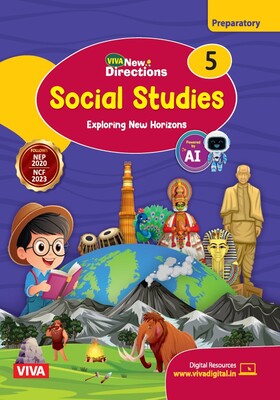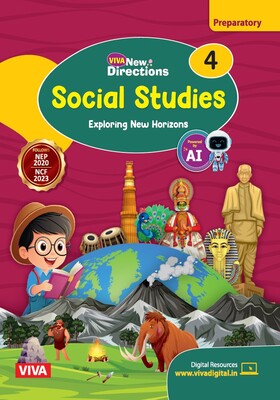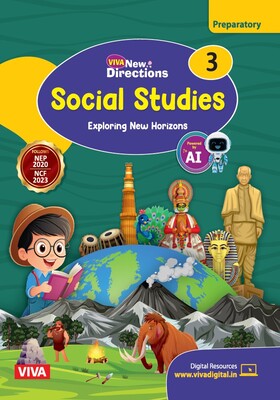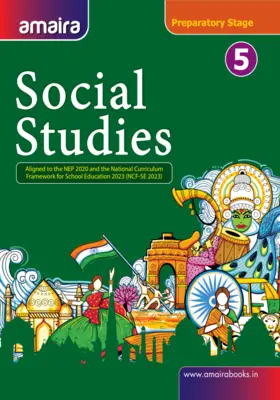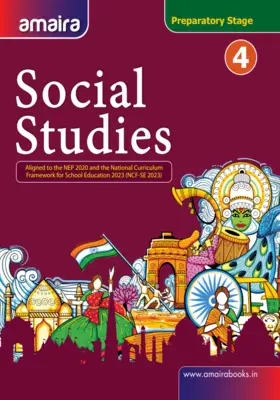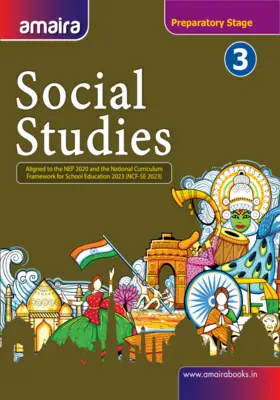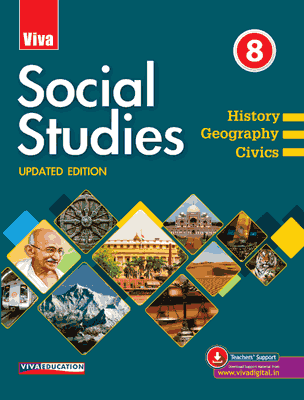
Viva Social Studies - 8 (Updated Edition)
Viva Social Studies - 8 (Updated Edition)
History, Geography, Civics
₹575.00
Go to cartISBN: 9789389401790
Bind: Paperback
Year: 2020
Pages: 272
Size: 8.5 x 11 Inch
Publisher: Viva Education
Exclusive Distributors: Viva Books
Sales Territory: Worldwide
Viva Social Studies is a set of eight books for classes 1 to 8, designed and developed keeping in mind the latest guidelines framed by the CBSE. The series helps to build knowledge about humankind and the physical and social world we live in. It is an activity-oriented series with creatively designed exercises and individual and group projects and activities.
Salient Features of Books 6 to 8
- Lucid language is used for easy comprehension.
- Colourful pictures and well-labelled diagrams help to reinforce the concepts.
- Various tasks are provided within each lesson in the form of Extract, Search and Surf, Picture-based questions and Answer Orally.
- Thinking skills are included as Brainstorm.
- Quick outline of the main topics is given as Learning Outcomes.
- Memory tool featuring salient points of the chapter is presented in Recap.
- Assessment tasks are presented in chapter-end exercises.
- Meanings and definitions of new words are given as Footnotes.
- Meanwhile (in History) helps to trace the contemporary scenario of the other countries in the same age.
- Web charts, tables, case studies, maps and many other features are given for quick reference.
- Each book is accompanied with Teacher's Resource Pack that includes Teacher's Guide and Digital Resources.
Teacher's Guide:
- Lesson Plans
- Answers to In-text Exercises
- Answer Key to Chapter-end Exercises
- Assessment Sheets
- Additional Activities and Projects
Teachers' Support material can be downloaded from www.vivadigital.in
Target Audience:
CBSE Students of Class 8.
Contents:
History
Chapter 1. The Modern Period • Periodization in History • Major developments around the world • Modern period in India • Sources
Chapter 2. The Establishment of Company Power • The British East India Company • The French East India Company • The Carnatic wars, the British in Bengal • Expansion of the British Empire, administration • The British power and supremacy
Chapter 3. Rural Life and Society • The agrarian policies of the British • Revenue farming system • Effect and impact of the British revenue policies • Growth of commercial crops • The indigo rebellion • Case Study: Impact on Punjab and Bengal
Chapter 4. Colonialism and Tribal Societies • The tribal life • Tribal life under British rule • Tribal Revolts
Chapter 5. Crafts and Industries • Industrial revolution and its effects • Indian textile industry • Iron and steel industries • Case Study: Deindustrialization of Indian textile industry
Chapter 6. Revolt of 1857 • Causes of the revolt • Beginning and spread of the revolt • The civilian rebellion • Suppression of the revolt • Failure and nature of the revolt • Effects of the Revolt
Chapter 7. Education and British Rule • Education in India in the pre-colonial times • Education in India under the British • Role of Christian missionaries in promoting western education • Effects of western education • National education—Mahatma Gandhi, Rabindranath Tagore • Case Studies: Aligarh Muslim University and Education in Baroda
Chapter 8. Women and Reform • Condition of women • Raja Ram Mohan Roy • Widow remarriage and child marriage • Women's education • Case Studies: Women's reform movements in Maharashtra and Bengal
Chapter 9. Challenging the Caste System • Caste reforms • The fight against untouchability • Reform movements among the Muslims, Parsis and Sikhs
Chapter 10. The Nationalist Movement • Emergence of Nationalism • Formation of political associations, moderates and extremists • Partition of Bengal and Swadeshi and Boycott movements • Muslim League, Indian Council Act 1909, Congress split and reunification • Revolutionary movements, the First World War and growth of Indian mass nationalism
Chapter 11. Gandhian Era (191-1947) • Emergence of Mahatma Gandhi, Government of India Act 1919, Rowlatt Satyagraha • Jallianwala Bagh massacre, Simon Commission, re-emergence of revolutionary activities, demand for dominion status • Civil Disobedience movement, Second World War, National Movement • Muslim League, demand for Pakistan, Quit India Movement, Subhas Chandra Bose and INA, towards independence • Case Studies: Khilafat and Non-Cooperation Movement, the Chauri Chaura Incident and Events between 1922-1929
Chapter 12. India After Independence • Challenges faced by the new government • Integration of Princely states, the freeing of French and Portuguese territories • Reorganization of states, preparing a Constitution • India's progress and development after Independence • India's foreign policy, India and her neighbours • India today
Geography
Chapter 1. Resources • Natural resources • Man-made resources • Human resources • Conservation of resources
Chapter 2. Natural Resources— Land, Soil and Water • Land resources, land use and landslide • Soil resources, soil types and soil conservation • Water resources and their conservation
Chapter 3. Natural Vegetation and Wildlife Resources • Importance of natural vegetation and wildlife • Factors affecting natural vegetation • Classification of natural vegetation • Natural vegetation in India • Conservation of natural vegetation • Distribution of wildlife • Conservation of wildlife
Chapter 4. Minerals and Power Resources • Types of minerals and their extraction • Distribution and conservation of minerals • Power resources—conventional and non-conventional • Conservation of power resources
Chapter 5. Agriculture • Factors influencing agriculture • Types of agriculture
Chapter 6. Major Crops • Crops and their classification • Main food crops • Cash crops and their types • Development of agriculture • Case Studies: Farming in India and USA
Chapter 7. Manufacturing Industries • Classification of industries • Factors aff ecting location of Industries • Industrial system • Industrial regions of the world and India • Distribution of major industries
Chapter 8. Major Industries • Iron and steel industry—comparing Jamshedpur and Pittsburgh • Cotton textile industry—comparing Ahmedabad and Osaka • Information technology industry—comparing Bengaluru and Silicon Valley
Chapter 9. Human Resources • Distribution of population • Factors affecting distribution of population • Population change and its pattern • Population composition
Civics
Chapter 1. The Indian Constitution • Need for laws • Constitution, its need and role • Amendments • Law and the Constitution • The Human Rights • Law and dissent
Chapter 2. Vision Set by Our Constitution • The Preamble to our Constitution • Ideals transformed into law • Fundamental rights • Directive principles of state policy • Fundamental duties • Case Study: Child labour in India
Chapter 3. Parliamentary Government of India • The Parliamentary system • The Parliament and its composition • Role of the Parliament • Bills and their types • Passing a law • The executive • Accountability of the government • Case Study: Debate between Rajendra Prasad and Jawaharlal Nehru
Chapter 4. Understanding Laws • Transforming need into law • Right to Education Act, its benefits and implications • Right to Information Act and its advantages
Chapter 5. The Judiciary • Civil and Criminal laws • The Indian Judicial system • Composition, functions and jurisdictions of the Supreme Court • Function of High Courts, Subordinate courts and Lok Adalats • Impartial and Independent judiciary • Case Study: Judicial Impartiality
Chapter 6. Role of the Police and Courts • Hierarchy in the police force • Functions of the police • Filing of an FIR • Role of the Courts • Understanding our criminal justice system • Case Study: Non-registration of FIRs
Chapter 7. Social Justice and the Marginalized • Marginalization in India • The Scheduled Castes • The Scheduled Tribes • The Other Backward Classes • Provisions in the Indian Constitution • Social and economic inequality • Reservations and quota system in India • Case Study: Social justice
Chapter 8. Untouchability • Untouchability • Manual scavenging and its existence in urban and rural areas • Laws and other efforts to end manual scavenging • Constitutional remedies against untouchability
Chapter 9. Economic Presence of the Government • Infrastructural activities • Activities in the social sector • Conclusion
Chapter 10. Law and Social Justice • Laws to prevent unfair practices • Enforcing safety laws • New laws to protect the environment
About the Authors:
Shrutakirti S. Rajan is an educational books author and editor, based in New Delhi. She graduated from Jesus and Mary College, Delhi University. She has completed her M.A. in History of Art from National Museum Institute, New Delhi.
Tilottama Mallik is a teacher with over 15 years teaching experience in a reputed school in Delhi. She has done her M.A. in Economics from Anna Malai University, Chennai; B.Sc. Hons., and B.M. in Geography from Calcutta University.
About the Series Editors:
Uttara Chakraborty is a retired professor, formerly, Department of History, Bethune College and Guest Lecturer, Presidency College and Presidency University. She has served with several government colleges in Kolkata under WBES (West Bengal Educational Service).
Jayita Kundu has been teaching at Mahadevi Birla World Academy, Kolkata. She graduated from Presidency College, Kolkata and has completed her Masters and M.Phil from Calcutta University.
